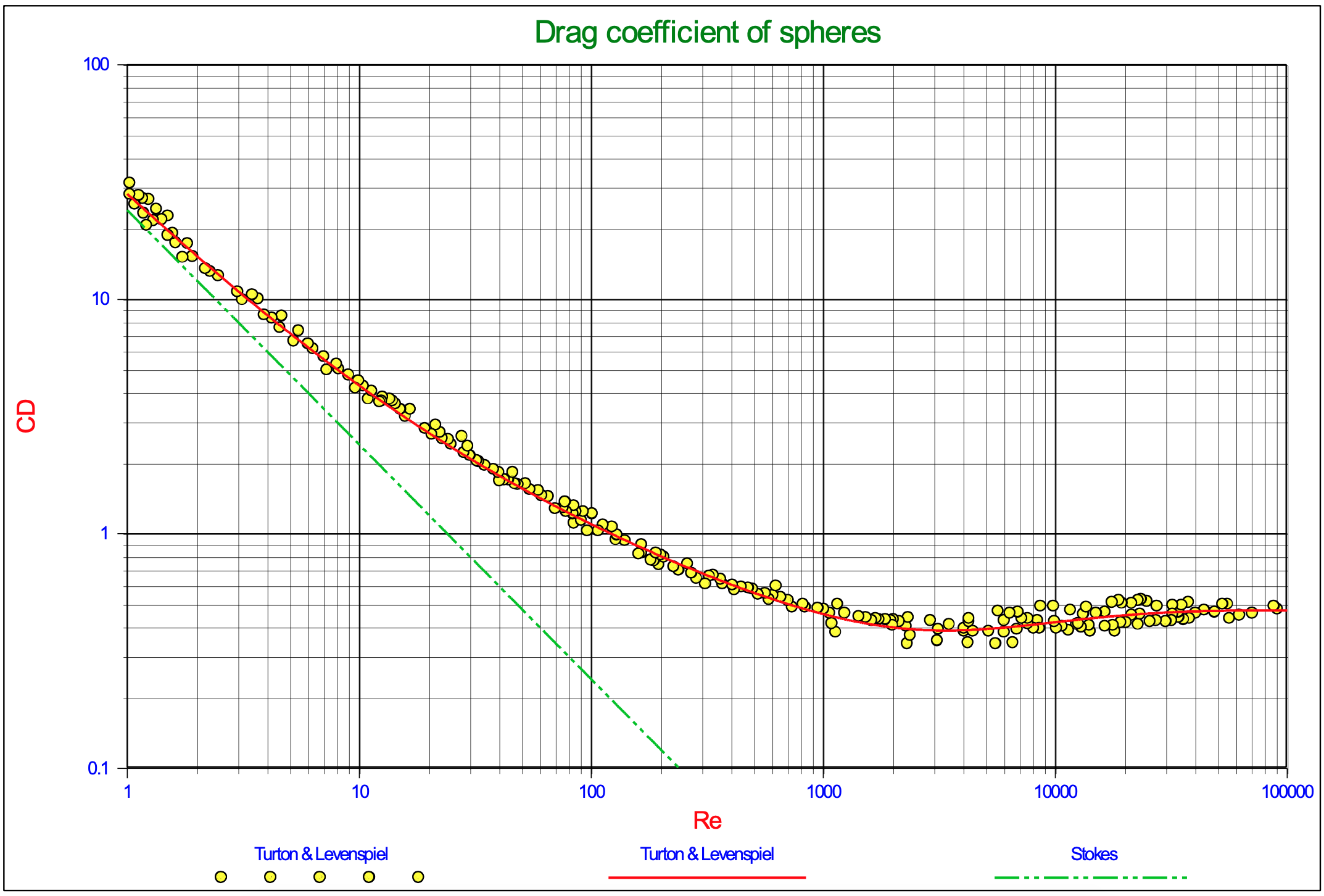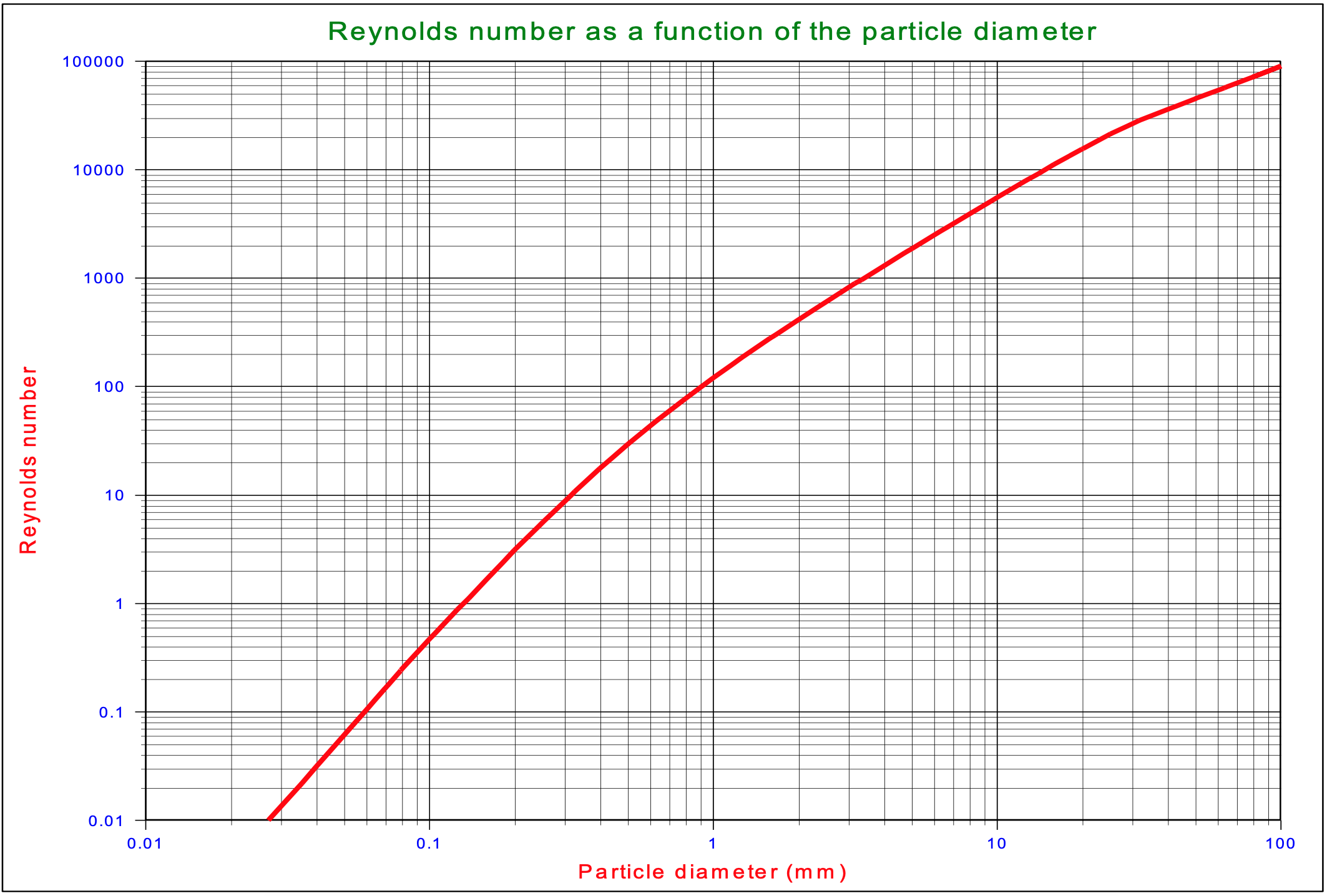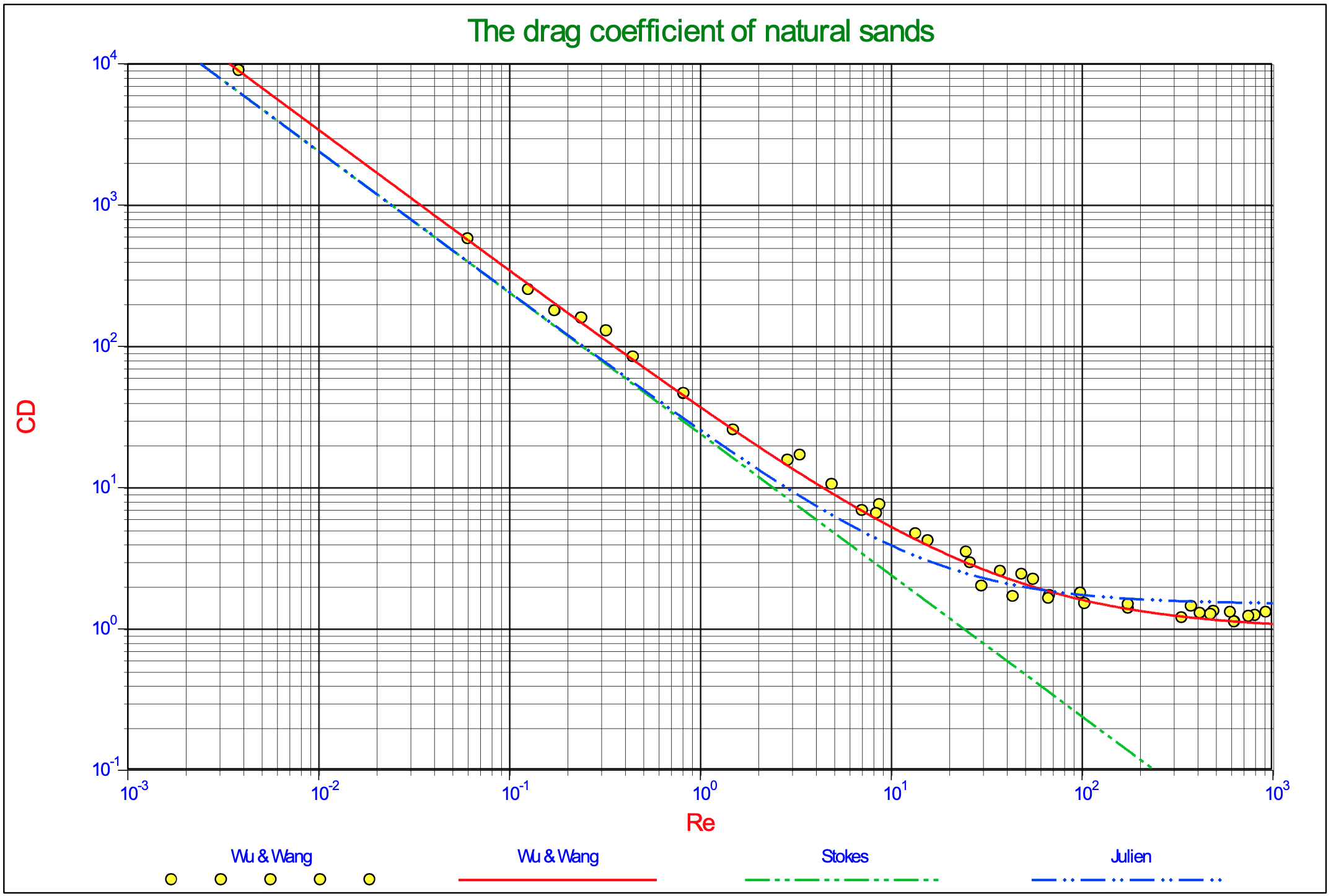4.3: The Drag Coefficient
- Page ID
- 29201
In equation (4.2-5) all parameters are assumed to be known, except for the drag coefficient CD.

The drag coefficient CD for spheres depends upon the Reynolds number according to:
The laminar region:
\[\ \mathrm{R} \mathrm{e}_{\mathrm{p}}<\mathrm{1} \quad \Rightarrow \quad \mathrm{C}_{\mathrm{D}}=\frac{\mathrm{2 4}}{\mathrm{R} \mathrm{e}_{\mathrm{p}}}\]
The transitional region:
\[\ \mathrm{1}<\mathrm{R} \mathrm{e}_{\mathrm{p}}<\mathrm{2 0 0 0} \quad \Rightarrow \quad \mathrm{C}_{\mathrm{D}}=\frac{\mathrm{2 4}}{\mathrm{R e}_{\mathrm{p}}}+\frac{\mathrm{3}}{\sqrt{\mathrm{R e}_{\mathrm{p}}}}+\mathrm{0 . 3 4}\]
The turbulent region:
\[\ \mathrm{R e}_{\mathrm{p}}>\mathrm{2 0 0 0} \quad \Rightarrow \quad \mathrm{C} \mathrm{D}=\mathrm{0 . 4 4 5}\]
As can be seen from the above equations, the drag coefficient CD is not continuous at the transition points of Rep =1 and Rep = 2000. To get a smooth continuous curve the following equations can be applied:
The laminar region:
\[\ \mathrm{R} \mathrm{e}_{\mathrm{p}}<\mathrm{1} \quad \Rightarrow \mathrm{C}_{\mathrm{D}}=\mathrm{R} \mathrm{e}_{\mathrm{p}} \cdot\left(\frac{\mathrm{2} \mathrm{4}}{\mathrm{R} \mathrm{e}_{\mathrm{p}}}+\frac{\mathrm{3}}{\sqrt{\mathrm{R} \mathrm{e}_{\mathrm{p}}}}+\mathrm{0} . \mathrm{3} 4\right)+\left(\mathrm{1}-\mathrm{R} \mathrm{e}_{\mathrm{p}}\right) \cdot \frac{\mathrm{2} \mathrm{4}}{\mathrm{R} \mathrm{e}_{\mathrm{p}}}\]
The transitional region:
\[\ \mathrm{1}<\mathrm{R} \mathrm{e}_{\mathrm{p}}<\mathrm{2 0 0 0} \quad \Rightarrow \mathrm{C}_{\mathrm{D}}=\frac{\mathrm{2 4}}{\mathrm{R e}_{\mathrm{p}}}+\frac{\mathrm{3}}{\sqrt{\mathrm{R e}_{\mathrm{p}}}}+\mathrm{0 . 3 4}\]
The turbulent region:
\[\ \mathrm{R e}_{\mathrm{p}}>\mathrm{1 0 0 0 0} \quad \Rightarrow \mathrm{C}_{\mathrm{D}}=\frac{\mathrm{1 0 0 0 0}}{\mathrm{R e}_{\mathrm{p}}} \cdot\left(\frac{\mathrm{2 4}}{\mathrm{R e}_{\mathrm{p}}}+\frac{\mathrm{3}}{\sqrt{\mathrm{R e}_{\mathrm{p}}}}+\mathrm{0 . 3 4}\right)+\left(1-\frac{\mathrm{1 0 0 0 0}}{\mathrm{R e}_{\mathrm{p}}}\right) \cdot \mathrm{0 . 4 4 5}\]

Figure 4.3-2 shows the particle Reynolds number as a function of the particle diameter for sands and gravels, using the Ruby & Zanke (1977) equation.
Another equation for the transitional region has been derived by Turton & Levenspiel (1986):
\[\ \mathrm{C_{D}=\frac{24}{R e_{p}} \cdot\left(1+0.173 \cdot R e_{p}^{0.657}\right)+\frac{0.413}{1+16300 \cdot R e_{p}^{-1.09}}}\]
It is known that for sands and gravels the drag coefficients, especially at large Reynolds numbers, are larger than the drag coefficient for spheres. Engelund & Hansen (1967) found the following equation based on measurements and found it best suited for natural sands and gravels (Julien, 1995):
\[\ \mathrm{C}_{\mathrm{D}}=\frac{\mathrm{2 4}}{\mathrm{R e}_{\mathrm{p}}}+\mathrm{1 . 5}\]
It must be noted here that in general the drag coefficients are determined based on the terminal settling velocity of the particles. Wu & Wang (2006) recently gave an overview of drag coefficients and terminal settling velocities for different particle Corey shape factors. The result of their research is reflected in Figure 4.3-3. Figure 4.3-3 shows the drag coefficients as a function of the Reynolds number and as a function of the Corey shape factor. Figure 4.3-4 shows the drag coefficient for natural sands and gravels. The asymptotic value for large Reynolds numbers is about 1, while equation (4.3-8) shows an asymptotic value of 1.5.
For shells lying flat on the bed, the drag coefficient will be similar to the drag coefficient of a streamlined half body (0.09), which is much much smaller than the drag coefficient for settling (3). So there is a large asymmetry between the settling process and the erosion process of shells, while for more or less spherical sand particles the drag coefficient is considered to be the same in each direction.
Figure 4.4-1 shows the CD coefficient as a function of the Rep number. In the transition area the equations are implicit. Iteration 1 shows the resulting CD values based on equations (4.3-1), (4.3-2) and (4.3-3), while iteration 2 shows the results based on equations (4.3-4), (4.3-5) and (4.3-6). It is clear from this figure that iteration 2 matches the observed data better than iteration 1, but equation (4.3-7) of Turton & Levenspiel (1986) matches the best. This is however for spheres and not for real sand and gravel particles.




